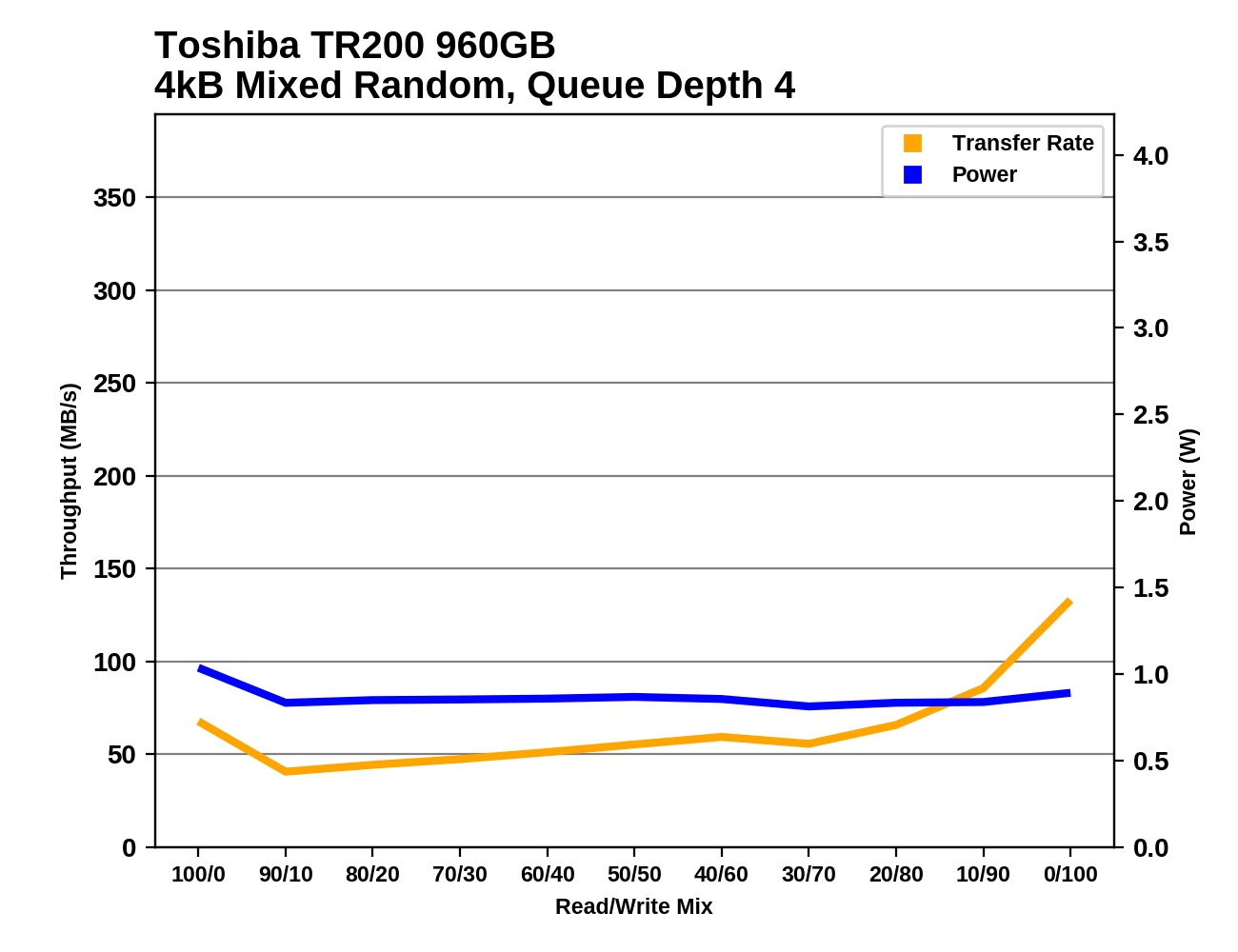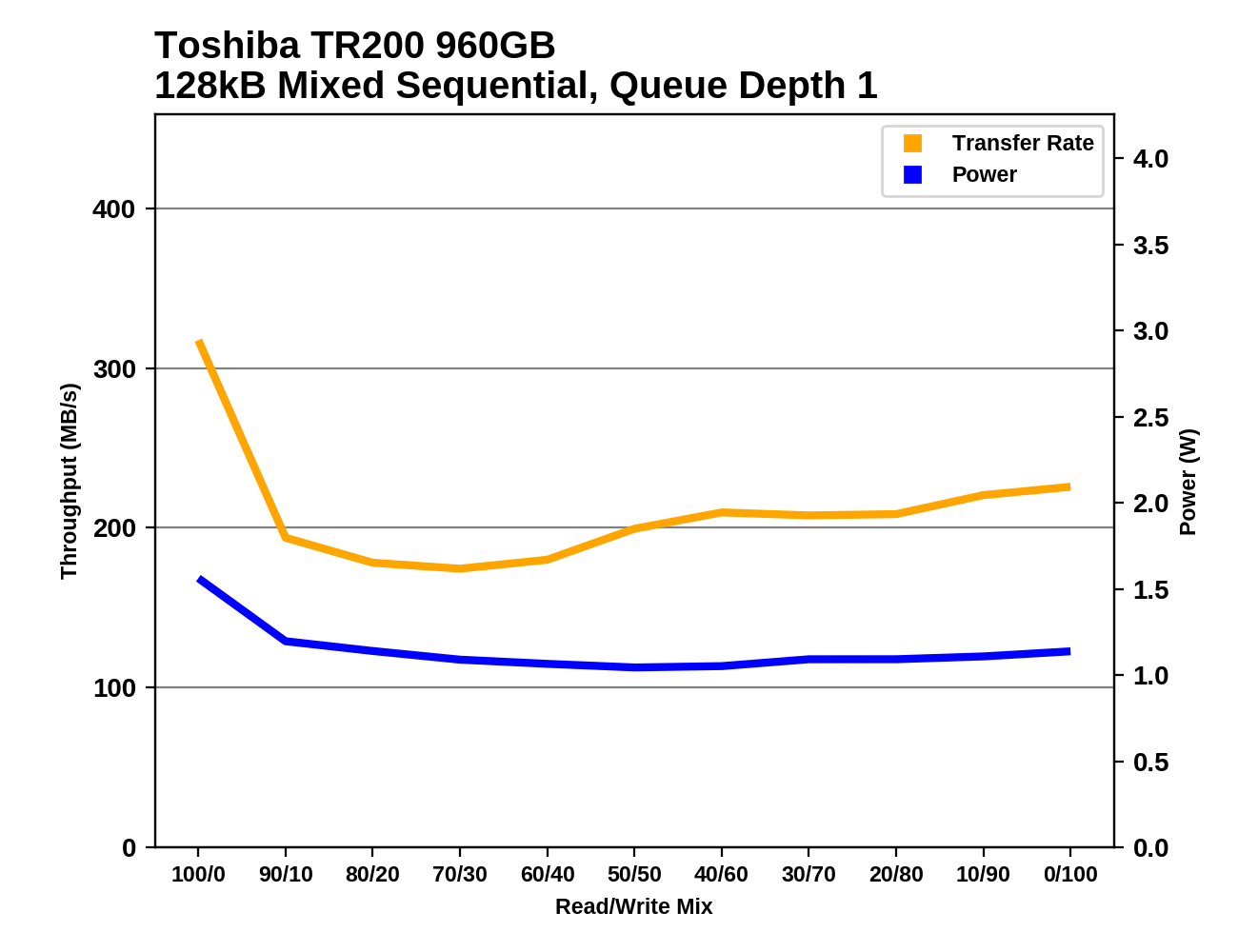The Toshiba TR200 3D NAND SSD Review: One Step Forward, One Step Back
by Billy Tallis on October 11, 2017 7:00 AM ESTMixed Random Performance
Our test of mixed random reads and writes covers mixes varying from pure reads to pure writes at 10% increments. Each mix is tested for up to 1 minute or 32GB of data transferred. The test is conducted with a queue depth of 4, and is limited to a 64GB span of the drive. In between each mix, the drive is given idle time of up to one minute so that the overall duty cycle is 50%.

The mixed random I/O performance of the Toshiba TR200 is much faster than the HP S700, but is slower than everything else, even the earlier Trion/TR series drives. Contemporary budget SSDs like the ADATA SU800 and Crucial MX300 are more than twice as fast.

The power efficiency of the TR200 during the mixed random I/O test is a marked improvement over the TR150 and is more than twice that of the HP S700, but that's not enough for the TR200 to rate much better than acceptable.
 |
|||||||||
The performance of the TR200 during the mixed random I/O test traces out a common bathtub curve shape, with performance dropping after the initial pure reads phase and climbing very slowly as the proportion of writes increases, before accelerating near the end of the test as the workload shifts to mostly writes. The TR200s don't show a large spike in performance at the very end of the test like the TR150 does, but at least they don't bottom out anywhere near as low as the HP S700.
Mixed Sequential Performance
Our test of mixed sequential reads and writes differs from the mixed random I/O test by performing 128kB sequential accesses rather than 4kB accesses at random locations, and the sequential test is conducted at queue depth 1. The range of mixes tested is the same, and the timing and limits on data transfers are also the same as above.

The larger two Toshiba TR200 models are marginally faster than their TR150 predecessors on the mixed sequential I/O test, but the 240GB has lost more than 12% of its overall performance. All of the TR/Trion series drives remain at the bottom of the chart, well below even the other DRAMless SSDs.

The TR200 climbs out of last place for power efficiency, and the 960GB model in particular is near the top of the chart along with the other DRAMless SSDs. The smaller two capacities have fairly average efficiency.
 |
|||||||||
All three of the TR200 models lose a lot of performance when writes are first added to the workload, but they regain a bit of performance through the first half of the test. The 960GB model gains a bit more performance in the second half of the test while the smaller models drop off again. The drives that do well on this test mostly either regain significant performance in the second half, or show steady increases across the entire test.










50 Comments
View All Comments
HollyDOL - Wednesday, October 11, 2017 - link
Have to admit, 250GB is enough so far, but it's tight, my next SSD will be at least 500GB for sure.yankeeDDL - Wednesday, October 11, 2017 - link
For XBONE and PS4 SSD make no sense, IMHO: you need large storage space, and speed is (nearly) irrelevant.At $89,99 you buy 3TB HDD (and some 4TB on discount) which will perform identically when connected via USB, but offer more than 10X the storage.
250GB SSD are nearly useless: just barely as a boot disk if the performance is "good", which it isn't in this case.
takeshi7 - Wednesday, October 11, 2017 - link
As someone who uses an SSD in their PS4 and Xbox One, I think it's worth it, but it definitely depends on the game. Forza and Elder Scrolls Online loads so much faster off of an SSD compared to a hard drive I've probably saved hours of loading screens. But in Destiny you have to wait for the servers and I've found an SSD doesn't cut as much time off of the loading screens.rrinker - Wednesday, October 11, 2017 - link
My work laptop has a 500GB 850 EVO, but I also run VMs on it so I have single files that are 30GB. My new machine at home has a 500GB 850 EVO, just because. I don't game on that one, it doesn't even have a discrete video card, it's my workbench computer for electronics stuff, and the Arduino IDE and Visual Studio don't need discrete graphics. The 500GB is actually probbaly overkill, but it had been sitting on my desk for 5 months waiting for me to install it in my OTHER desktop. That one is an older machine but with a 970 it easily plays anything I play. Other than the video card, the machine is about 6 years old, originally built with a regular hard drive but then I upgraded it with a 250GB 830 EVO. It still has a spinny disk a D drive an the real space hog but not performance intensive things all go there, so so far the 250GB has been sufficient (hovers around 90GB free since upgrading to Win 10). I don't game a lot, and when I do I'm a serial gamer - one game at a time. When I get bored with that and move on to the next, I uninstall the old one.steve wilson - Thursday, October 12, 2017 - link
Would that not be more of a monogamous gamer? I'm pretty much the same, I stick with one game most of the time, up until recently. PUBG and Rocket league now.rocky12345 - Wednesday, October 11, 2017 - link
Yep you got a point the games are getting so big that 250-500GB space gets tight real fast. I have a 500GB SSD and 3 4TB drives in Raid 0+1 config which makes the mech drives perform very good. If I do find a game that takes a while to load up off of the 4TB drive config I just copy it to the SSD Drive and see very quick load times then. 2 games come to mind so far that I have done this with GTA V & Fallout 4. Both of those games see a huge boost in loading times shortened by doing this.Fallen Kell - Thursday, October 12, 2017 - link
Just trying to figure out how you are using 3 drives to do a 0+1 RAID which clearly needs 4 drives to work... I mean I guess you could have created 2 partitions on each drive and then 0+1'ed the partitions and were extremely careful in the strip'ed mirror creations such that drive 1 has mirror of drive 3, drive 2 has mirror of drive 1, and drive 3 has mirror of drive 2...Again, just wondering.
rocky12345 - Thursday, October 12, 2017 - link
Yea I just asked my friend who set it up and he said it was setup as Raid 01 hybrid 3 drive setup. He said yes 4 drives are much better for this setup. I asked him why he did not tell me this at the beginning his response "you never asked".the way he explained it was to picture it as with drive 1 with A1,A2,A3 Drive 2 with A1,A3,A4 Drive 3 with A2,A3 he even showed me a picture of this to make me see what he did and explained to me.
Now I am debating on just killing this raid setup and just making a Raid 0 config with 2 of the drive and have the third as a storage backup or picking up another 4TB drive and doing the proper configuration and not a non standard like I have now. He seems to think I should just leave it alone as it works well and the speed is good as it sits. Not sure what to do now I do not like having things done half fast...lol
rocky12345 - Thursday, October 12, 2017 - link
I just wanted to add reading your comment it looks like he may have set it up the way you said it could be done because he did say it was a bit tricky meshing it all together so it would work properly with the 3 drives only. If you think I should get a another 4TB drive and just have the raid configured again I am thinking that is the best option. I won't lose anything it is all backed up on externals anyways and whatever is not are just not worth backing up.Pork@III - Wednesday, October 11, 2017 - link
Sequential Read 555 MB/s 555 MB/s 555 MB/sSequential Write 540 MB/s 540 MB/s 540 MB/s
7 years long periood of same speed of ordinary SSD's